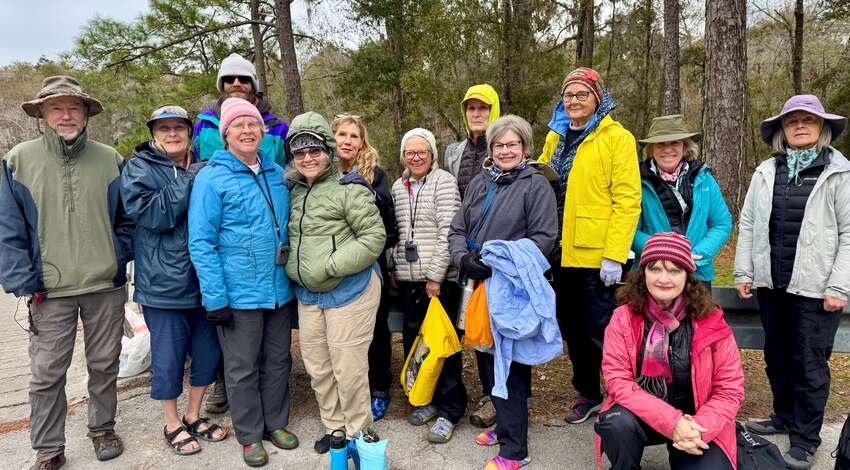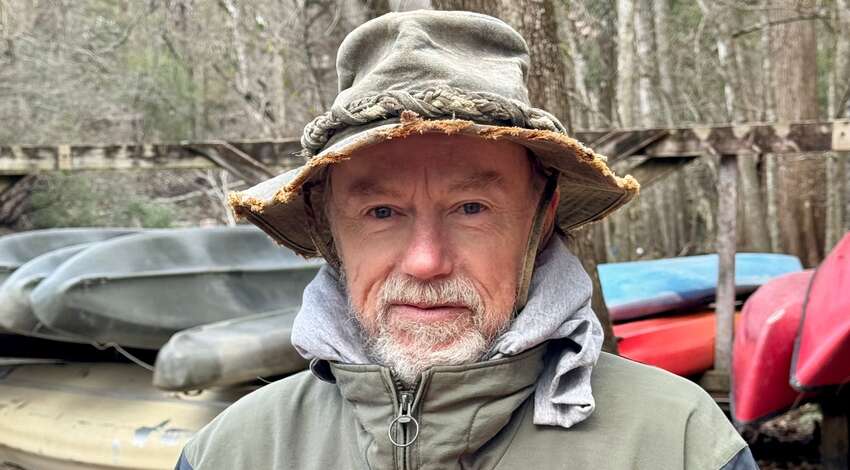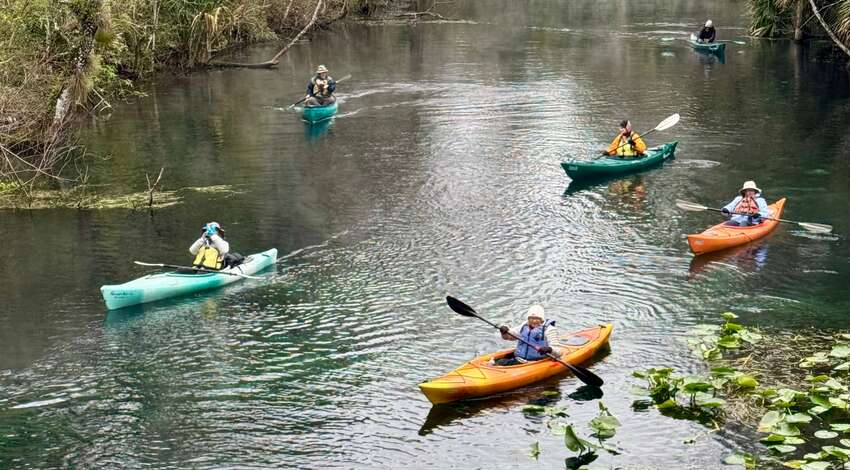Road Scholar Instructor Lars Andersen Sparks Delight on North Florida’s Rivers and Springs
Ten women in their 70s paddle single kayaks along North Florida’s Silver River past Snowy egrets and Pileated Woodpeckers squawking in the centuries-old cypress trees. One thousand-pound manatees hover in the warm spring water below. Striped mullet periodically leap a foot into the air around the paddlers, eliciting yelps of surprise and then laughter. Leading the group, 66-year-old river guide Lars Anderson in his weathered canvas sunhat describes the region’s waterways over a headset for all to hear.

Lars Andersen (far left) and group
“Relationships with rivers are like those with people,” he writes on his blog, River Guides Journal. “Some are born of simple geography, like the next-door neighbor who, through nothing more than occasional chats over the fence, becomes as familiar as family. Others are the stuff of chemistry, sparked to life by something as simple as a glance, at the driver in the car next to us at a stop light; at a person studying at the next table in the library; at a stranger who sits next to us at a lecture … at a glistening pool of blue water that we stumble upon, deep in a Florida forest.”
Andersen has worked a full-time river instructor for 28 years, and he’s a longtime instructor for Road Scholar. Currently, he is an expert in Fort White, Fla., and he works in partnership with other instructors in the Gainesville, Fla., area, leading Road Scholars to glistening pools of blue water alongside the Silver River, and sparking their relationships with the Ichetucknee and Santa Fe Rivers, as well. As an instructor for the Florida Master Naturalist Program and author of several regional guidebooks including Paddler's Guide to the Sunshine State he provides a wealth of knowledge on the trees and plants and animals that call this sensitive area home.
Andersen grew up exploring prairies and waterways in Gainesville. He got his start as an environmental steward at 9 years old, volunteering at a local museum to sort piles of Pied-billed Grebe bones. He studied Wildlife Ecology at Santa Fe College and then set off hitchhiking toward Alaska. “I got waylaid by natural beauty and low funds, first in Estes Park, Colorado, and then Coos Bay, Oregon, for three years, where I worked in the woods doing reforestation,” he explains. “Never did make Alaska.”
Instead, he returned to North Florida and began guiding groups eager to learn about the rivers and springs.

Cornelia Holbrook, owner of Gainesville’s Sweetwater Branch Inn, oversees Road Scholar’s Kayaking North Florida’s Sacred Springs & Rivers program several weeks out of the year. She calls Andersen “an encyclopedia of knowledge. He never hits you over the head with it, you never feel like he’s regurgitating things,” she says. “It’s always a unique narrative. He gives you cultural history, as well as the natural history of the area, and he’s able to intertwine these into stories.”
On the Silver River, Andersen recounts the history of the area beginning with the Seminole people who lived in villages along its banks. He regales paddlers with the wry origin story of the troop of rhesus macaques who chatter in the red maples and oaks — an excursion boat operator in the 1930s released a handful of the monkeys on an island for the enjoyment of tourists, thinking the animals couldn’t swim. Almost 100 years later, hundreds of rhesus macaques populate the riverbanks.
Around another bend, Andersen slows his kayak and points. “A diver found a mammoth bone over there,” he tells paddlers. “Underwater archaeologists dug them all out in the '70s. Paleontologists call this site ‘The Boneyard.’”
Among the fun facts about rivers, Andersen inserts cautionary tales to illustrate the issues that human carelessness can cause for the other species sharing the region. For 25 years, he’s spoken out about the plight of the manatees, urging other outfitters to stop allowing tourists to swim with the giant animals where they’re wintering in the warm springs. Too many swimmers, he explains, stress the manatees and sap the energy they need to hunt for food. He allows us to swim, but only in a spring adjacent to a local park in a pool of warm water that’s manatee-free.
A few minutes later on our paddling journey, we glide close to a flock of White Ibises, their bright orange bills and orange legs just visible behind a palm’s broad leaves. Andersen points to a tall, long-necked bird — an Anhinga — on a log with its wings outspread to catch a bit of tepid sunshine. “Somebody left a child’s sock on the bank of the Silver River last year, and an Anhinga tried to make a nest with it,” he tells us. “The sock got stuck on the bird, and rehabilitators had to rescue it.”

Retired teacher and Road Scholar Jan M. appreciates Andersen’s robust concern for riparian environments. “Lars clarified the plight of the manatee as a tourist attraction and the possibility that we were influencing their lives in a negative way,” she explains. “As an educator, I could see that he loved the rivers deeply and shared his experiences generously.”
Generosity guides Andersen’s work as both an environmental activist and a Road Scholar instructor. Last fall, he fell and fractured three lumbar vertebrae. Still, two months later, he led an all-women’s group along some of his favorite waterways, paddling for five hours a day and hoisting kayaks up over his head at put-ins and take-outs despite considerable back pain.
“I love my work, so, while it hurts a bit, teaching about nature and our rivers heals me in other ways,” he says. “Also, the neurosurgeon told me kayaking is good physical therapy for healing those factures.” We on Kayaking North Florida’s Sacred Springs & Rivers found that kayaking is good mental therapy, as well.
In River Guides Journal, Andersen describes the joy he feels when choosing the rivers for each tour he leads: “I see grizzled old-timers, slow but deliberate in their movements, alongside glistening sprites, who spend their days singing and dancing and playing with every boulder and snag they encounter; I see sages, whose rock-bone faces are scrawled with lessons of the ages, next to geologic youngsters. I see places as familiar and dear to me as old friends and family members.”
Over decades, he’s introduced hundreds of Road Scholars to these rivers — these venerable old friends and family members — with generosity and delight.
Melissa Hart's writing has appeared in The New York Times, Smithsonian, Nat Geo Kids, Orion and numerous other publications. She's the author, most recently, of Better with Books: 500 Diverse Books to Ignite Empathy and of Down Syndrome Out Loud: 20+ Stories about Disability and Determination. Find her at www.melissahart.com
